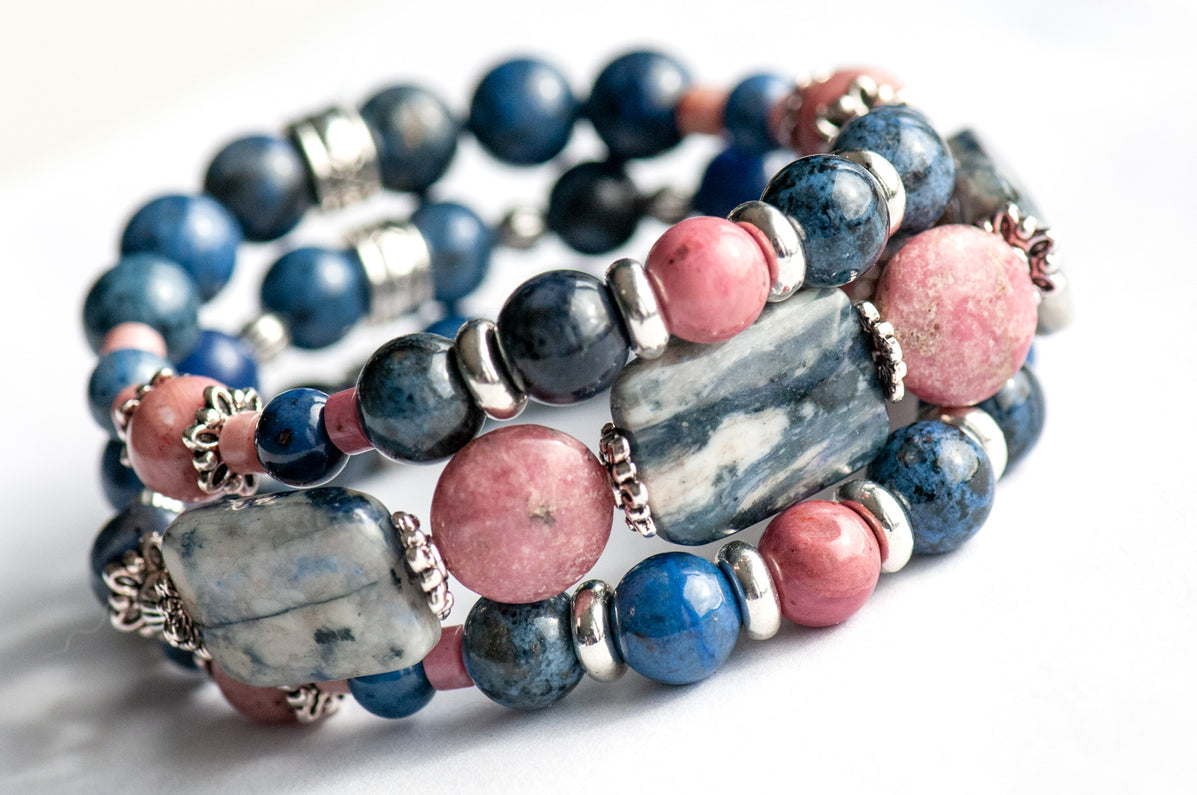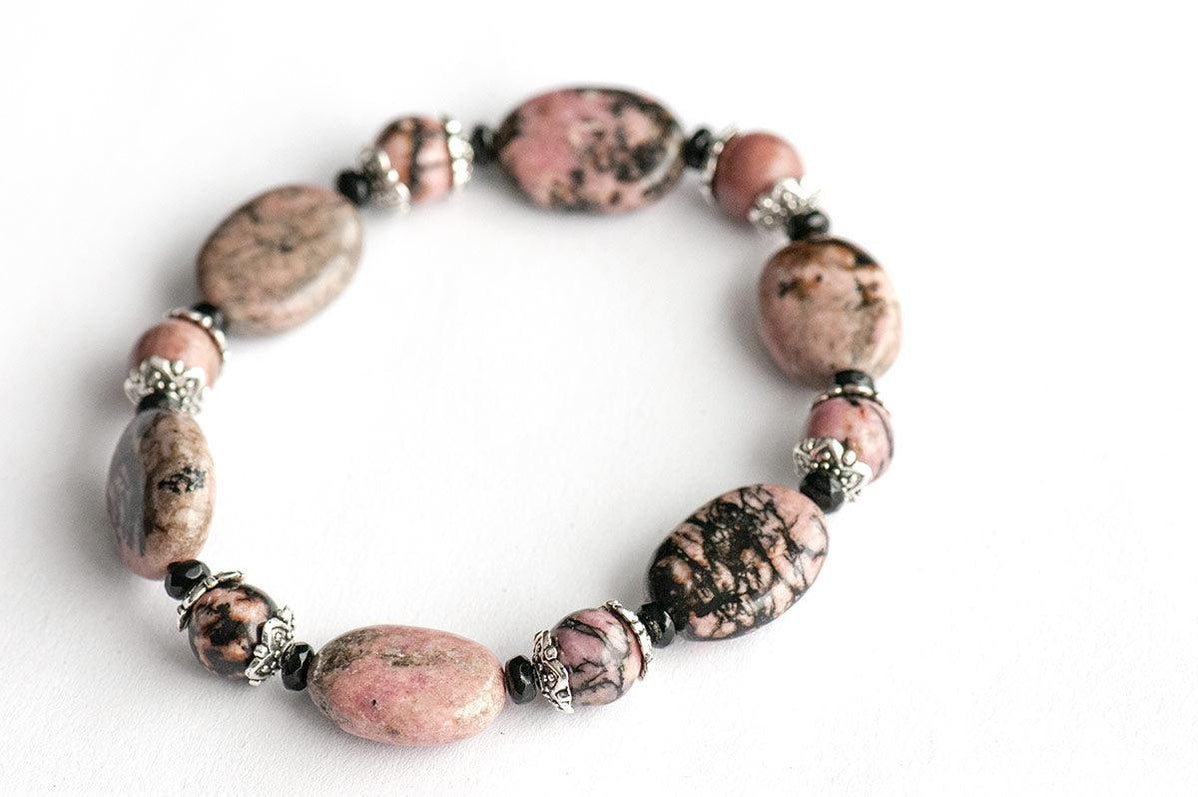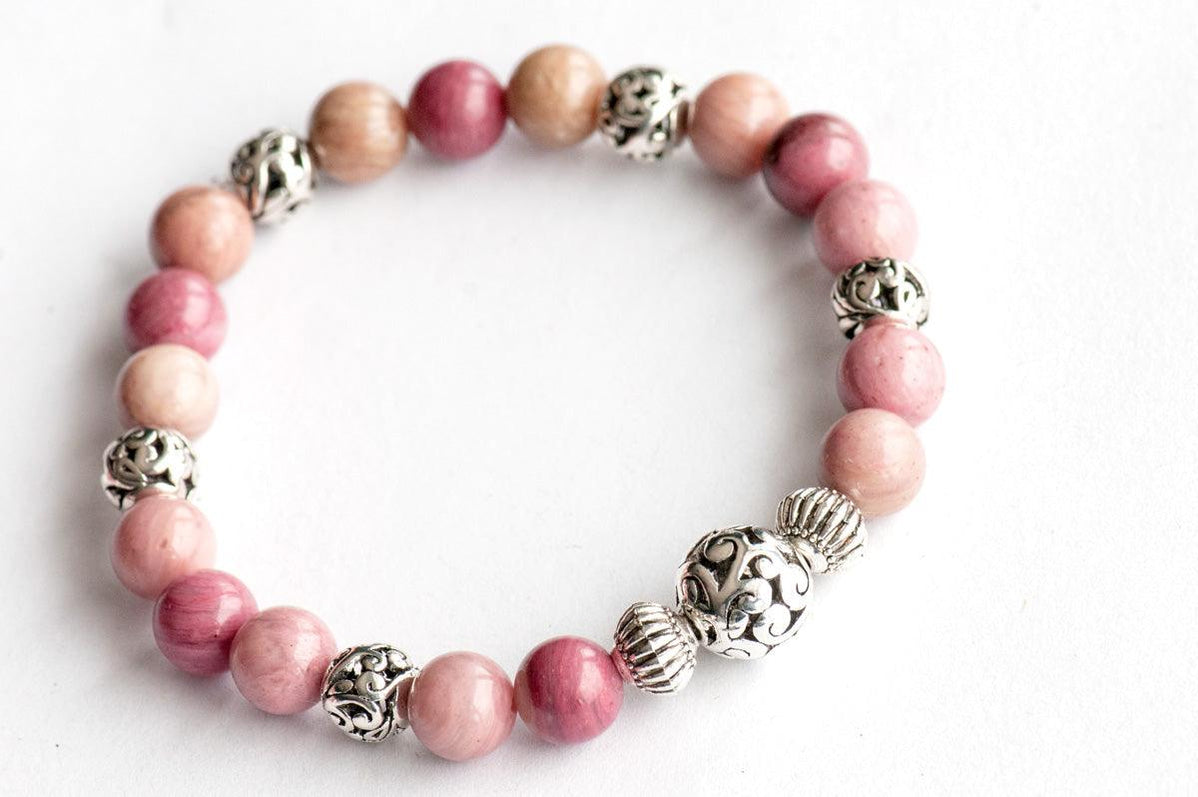Gemstone discovery can be as exciting as it is complicated, especially in the world of rhodochrosite rhodonite. The names of these gemstones come from similar Greek or Latin root words, which can confuse even the experts. With their gorgeous colours, these two gems leave collectors and enthusiasts in a delightful dilemma. At first glance, their colours may look similar, but lean in a little closer and a tapestry of unique characteristics unfolds. Rhodonite is a manganese silicate mineral, while rhodochrosite is a manganese carbonate mineral, and that’s the foundation of their differences.
Beautiful and charming, rhodochrosite and rhodonite don’t grab the attention of jewellers and collectors; they tell a story of distinct beauty and value, painted by their composition, colours and light.
While these gemstone cousins share common manganese roots and a few visual hints, the art is in teasing out their subtle differences. Rhodonite ranges from 5.5 to 6.5 on the Mohs scale, while rhodochrosite ranges from 3.5 to 4, making rhodonite harder and more durable.
Whether you choose these stones for their ornamental beauty, the soul of your next piece of jewelry or the pride of your growing collection, diving into what makes them different is more than a lesson in gemology – it’s a path to informed decisions.
This doesn’t resonate with you; it echoes through the market corridors, which affects the price and prestige each gemstone commands.
Introduction to Pink Gemstones
Pink gemstones have long been cherished for their beauty and emotional resonance. Among the myriad pink gemstones, rhodochrosite and rhodonite stand out for their unique characteristics and healing properties. Rhodochrosite is particularly noted for its vibrant pink color, which sets it apart from other pink gemstones. These two beautiful pink gemstones are visually captivating and hold significant emotional healing benefits. Rhodochrosite, with its delicate bands of pink and white, and rhodonite, with its striking black veining, offer a spectrum of aesthetic and metaphysical qualities. Whether you are a seasoned collector or a newcomer to the world of gemstones, understanding the distinct features of rhodochrosite and rhodonite can enhance your appreciation for these emotional healing stones. This guide will explore the differences and similarities between these two beautiful pink gemstones, providing a comprehensive understanding of their unique properties and uses.
Properties of Rhodochrosite and Rhodonite: Manganese Carbonate Mineral

-
Composition and Type:
-
Rhodochrosite: Manganese carbonate mineral
-
Rhodonite: Manganese silicate mineral
Transparency:
-
Often opaque in jewelry
-
Crystal specimens may be semi-translucent
-
Transparent stones are rare and highly prized
Appearance:
-
Rhodochrosite: Rhodochrosite's bands can vary in colour, showcasing a range from light to hot pink, often contrasted by white, light gray, or tan shades.
-
Rhodonite: It may have black manganese oxide inclusions, which can give it a veined appearance with black veins. Its colours range from pink to rosy-red to crimson and can also have orange or brownish-red shades. Rhodonite often has dark-coloured uneven bands, while rhodochrosite has lighter-coloured, mostly parallel colour banding.
Physical Characteristics:
-
Hardness on the Mohs scale:
-
Rhodochrosite: 3.5-4
-
Rhodonite: 5.5-6.5
-
-
Lustre:
-
Rhodochrosite: Vitreous to pearly
-
Rhodonite: Vitreous to pearly
-
-
Common formation: Metamorphic rocks and hydrothermal veins
-
Rhodonite versus Rhodochrosite Colours

Rhodonite and rhodochrosite have a primary pink colour, making them popular in jewelry. Rhodochrosite is a lighter rose-like pink and can go red. This stone has a white or yellowish-gray veining pattern that runs mostly parallel lines with occasional irregularities. Rhodochrosite can also have concentric circles or orb-like markings, adding to its unique beauty.
Rhodochrosite is known for its vibrant pink colour, ranging from light pink to deep rose pink, often with white, light gray, or tan bands. The intensity of the banding can vary depending on the depth of the rose-red colour. Rhodochrosite’s colour range is light pink to deep rose pink, corresponding to different healing and emotional energy types. These colours can help you connect deeper with your emotional landscape and personal growth.
Rhodonite appears opaque and has striking black patterns from manganese oxide inclusions. This creates a bold contrast against its bright pink background, which can range from pastel to deep red. The rhodonite veining is less structured than rhodochrosite; no parallel lines exist.
Both can vary in transparency from semi-translucent to opaque, adding to their depth and texture. These colour patterns and crystal inclusions are the key to differentiating the two almost similar stones. Rhodonite is found in metamorphic rocks, while rhodochrosite is found in hydrothermal veins; hence, their origin differs.
Historical Significance of Rhodonite and Rhodochrosite
Both rhodonite and rhodochrosite are valued for their beauty. Rhodonite is often part of collectors' collections or made into jewelry and ornate sculptures. These stones are also known for self-love and emotional healing, helping individuals cultivate self-love, emotional balance, and a deeper connection with themselves. Rhodochrosite is too soft for industrial use, but its beauty makes it a favourite among lapidary enthusiasts.
Global Distribution of Rhodochrosite and Rhodonite
Rhodochrosite is found in cavities of sedimentary and metamorphic rocks. It is famous for forming with silver, sometimes a secondary find in silver mines. The best rhodochrosite crystals are from Colorado; other sources are Argentina, Peru, South Africa, Mexico, Russia, Romania, Spain, Gabon, China, Japan, and Montana in the United States. But these top-quality specimens are rare.
-
Argentina: Known for rhodochrosite and rhodonite
-
Russia: Both gemstone varieties
-
South Africa, Australia: Rhodochrosite reported
-
Peru, Mexico: Both rhodochrosite and rhodonite
-
China, Japan: Rhodochrosite
-
United States (Colorado, Montana): Rhodochrosite and some rhodonite
Rhodonite, which is found in metamorphic rocks, is rarer than rhodochrosite. Global deposits are in Argentina, Brazil, Peru, the United States, Canada, Australia, India, Russia, Sweden, and England, but these are smaller and more scattered. Rhodonite is considered more affordable because it is more abundant than rhodochrosite. Both are cut into jewelry items, cabochons, to polished beads. Rhodochrosite is often slab cut for its smooth surface and rhodonite, though sometimes faceted stones are used as collectors because of their fragility. Small, independent designers make unique jewelry pieces like bracelets, necklaces and earrings. When rhodochrosite is cut into cabochons or beads for jewelry like a rhodochrosite bracelet it becomes more affordable, $1-$5 per carat. High quality rhodonite gemstones can cost $150-$500 per carat if under 10 carats, making it more accessible to many.

In search of gemstone jewelry that is emotional balance and heart-centred energy, look for creations by niche designers to get a Rhodonite and rhodochrosite Jewelry Collection. Since major retailers have limited options for those who prefer these types of stones, it is recommended to check out boutique businesses.
Significance of Rhodochrosite and Rhodonite
Metaphysical Properties of Rhodochrosite and Rhodonite: Emotional Healing
Rhodochrosite is associated with nurturing feelings of peace, compassion and love. It is said to comfort emotional wounds, empty emotional holes, alleviate stress and boost self-love.
-
Love & Compassion: Enhances emotional connections and compassionate understanding.
-
Emotional Healing: Helps to recover from psychological stress.
-
Self-Esteem: Promotes positive self-image.
Rhodonite symbolizes balance, meaning, and tranquillity. It is often associated with love and forgiveness and is believed to absorb negative energy.
-
Balance & Grounding: Establishes emotional balance and sense of grounding.
-
Strength & Vitality: Associated with fortitude and dynamic energy.
-
Forgiveness: Encourages the release of resentment and embracing forgiveness.
Although they have individual properties, both stones are connected to the heart chakra. They often emphasize the importance and meaning of listening to one’s heart and are said to be good companions during times of grief or loss.

When considering their supposed health benefits, please note that no scientific evidence supports their effectiveness in healing. Their healing properties are based on personal beliefs and do not replace professional healthcare.
-
Heart Chakra: Love and emotional connection.
-
Healing Attributes: Comforting presence, not medically proven.
-
Jewelry: Wearing as accessories can give the subjective feeling of wellness.
In summary, while Rhodochrosite and Rhodonite have metaphysical roles in emotional and spiritual wellness, be practical about their use.
Rhodonite and Rhodochrosite in Mythology and Culture
Although rhodonite and Rhodochrosite crystals are often mistaken for each other due to their pink colour, they have distinct places in mythology and cultural beliefs.

-
Rhodonite:
-
Associated with emotional healing and forgiveness across cultures.
-
Believed to foster compassion and confidence.
-
Considered a rescue gem to calm panic in traumatic situations.
-

-
Rhodochrosite:
-
In some mythologies, it is thought to represent the compassionate heart and is linked to selfless love.
-
Tribal lore often associates it with the inner child to bring playfulness and joy.
-
In some South American cultures it is known as Inca Rose, where it is believed to be the blood of former rulers turned to stone.
-
Historical Significance of Rhodochrosite and Rhodonite
Rhodochrosite and rhodonite have a rich and fascinating history across cultures and centuries. Rhodochrosite, often called the “Inca Rose,” was highly prized by the Inca civilization for its vibrant pink colour and was believed to possess powerful spiritual properties. The Incas considered rhodochrosite to be the blood of their ancestors turned to stone, symbolizing eternal love and compassion. This gemstone was often used in ceremonial objects and jewelry, reflecting its esteemed status.
Rhodonite, with its deep pink hues and black manganese oxide inclusions, has its own unique historical significance. In Russia, rhodonite was traditionally used in baby care, believed to promote emotional balance and stability. It was also used to create ornate sculptures and jewelry, showcasing its aesthetic appeal. Across various cultures, rhodonite has been associated with emotional healing and forgiveness, making it a cherished stone for those seeking to cultivate inner peace and emotional resilience.
Both rhodochrosite and rhodonite have been valued not only for their beauty but also for their emotional and spiritual benefits. Their historical significance adds depth to their allure, making them treasured additions to any gemstone collection.
Pink Gemstones similar to Rhodonite and Rhodochrosite
Rhodonite and rhodochrosite are often used interchangeably in jewelry designs due to their similar appearance and aesthetic compatibility. Here are some stones that resemble:
-
Rose Quartz: Often has a pale pink colour that can mimic rhodonite and rhodochrosite.
-
Pink Opal: Shares the soft pink tones but lacks the veining.
-
Pink Moonstone: While similar in colour, they may have a blotchy pattern without the veining.
-
Pink Coral is sometimes a match, but its pink is more orange and doesn’t have veining.
Imitation Rhodochrosite looks so much like the real deal that it’s hard to tell at a glance. However, under microscopic examination, the differences become visible. This imitation is more affordable for creating various jewelry pieces—bracelets, necklaces, earrings, rings—and achieving the look without the higher cost of genuine stones.
Rhodochrosite Properties
Rhodochrosite is loved not only for its beauty but also for its healing properties. This pink gemstone is a powerful tool in emotional healing, self-love, and balance. It’s known to heal emotional wounds and bring a sense of calm and well-being, which is why it’s a popular stone in crystal healing.
Rhodochrosite's healing properties are often linked to its spiritual significance. It symbolizes nurturing and innocence and is believed to offer emotional benefits.
One of the notable features of rhodochrosite is its strong connection to the heart chakra. This connection is believed to open and balance the heart chakra, love, compassion and emotional harmony. Working with rhodochrosite crystals can cultivate self-love, self-worth and self-acceptance. These crystals are said to develop a positive self-image and emotional healing and balance.
Rhodochrosite crystals can be very helpful for those experiencing emotional pain or trauma. They’re believed to give comfort and support, heal emotional wounds, and restore emotional equilibrium. Whether worn as jewelry or used in meditation, rhodochrosite crystals are a beautiful and powerful tool for those who want emotional healing and balance.
Rhodochrosite and Rhodonite Characteristics
Rhodochrosite and rhodonite are two pink gemstones that captivate with their unique characteristics and colours. Rhodochrosite, a manganese carbonate mineral, is known for its pink and banded appearance. Rhodochrosite's bands can range from light to hot pink and can be interspersed with white, light gray, or tan, creating a beautiful pattern. With a hardness of 3.5-4 on the Mohs scale, rhodochrosite is soft, a delicate yet lovely choice for jewelry and crystal healing.
Rhodonite is a manganese silicate mineral known for its pink colour and veined appearance. It often has black manganese oxide inclusions that create striking black patterns against its pink background. Rhodonite’s colour range is pink, rosy-red, and crimson, sometimes extending to orange or brownish-red. With a hardness of 5.5-6.5 on the Mohs scale, rhodonite is more durable than rhodochrosite, a practical choice for many applications. Both rhodochrosite and rhodonite are used for emotional healing and balance. Rhodochrosite is associated with feelings of peace, compassion and love, while rhodonite is linked to emotional equilibrium, strength and forgiveness. These two pink gemstones are used in crystal healing, each with its own metaphysical properties for emotional well-being.
In summary, while rhodochrosite and rhodonite share the same pink colour and emotional healing properties, they are distinct. Rhodochrosite’s banded appearance and soft nature differ from rhodonite’s veined patterns and harder nature, making each a unique and valuable addition to any collection.
FAQs
What Sets Rhodochrosite Apart from Rhodonite?
When distinguishing rhodochrosite from rhodonite, note the difference in:
-
Colour Variations: Rhodochrosite has pink to red colour with white banding. Rhodonite has a deeper pink to red-brown colour, occasionally with black manganese oxide inclusions.
-
Hardness: Rhodonite is slightly harder than rhodochrosite.
Identification Techniques for Rhodochrosite and Rhodonite
To identify these two stones:
-
Examine Streak: Rhodochrosite leaves a white streak, and rhodonite is closer to its colour.
-
Study Appearance: Look for rhodochrosite’s banding and rhodonite’s black inclusions.
-
Test for Hardness: Perform a scratch test. Rhodochrosite is more easily scratched than rhodonite.
Spiritual Qualities of Rhodochrosite and Rhodonite
Both stones are believed to:
-
Rhodochrosite: Emotional healing, love and compassion.
-
Rhodonite: Achieve one’s potential, confidence and purpose.
Comparative Value and Pricing of Rhodochrosite and Rhodonite
Value and price are influenced by:
-
Purity and Colour: Clear and vibrant colours fetch higher prices.
-
Rarity: Rhodochrosite is rarer, so it may cost more.
-
Size and Quality: Larger and higher quality specimens are more valuable in both.
Wear Rhodochrosite and Rhodonite Jewellery
Wearing these stones as jewelry is said to:
-
Rhodochrosite: Enhance emotional well-being and personal power.
-
Rhodonite: Ground emotions, resilience.
Synergistic Use of Rhodochrosite and Rhodonite
Combining these stones is thought to:
-
Harmonize: RhodoRhodonite'sing rhodochrosite's compassionate energy can bring balance.
-
Layered Jewellery: Wearing different pieces with each stone may look good and give you a blend of their properties.
Conclusion
In conclusion, rhodochrosite and rhodonite are unique and beautiful pink gemstones offering various benefits and properties. Whether you are looking for a gemstone to promote emotional healing, balance, and stability or add elegance to your jewelry collection, rhodochrosite and rhodonite are excellent choices. Rhodochrosite, with its soothing bands of pink and white, is known for healing emotional wounds and fostering self-love. With its striking black veining, Rhodonite is celebrated for its grounding energy and capacity to promote emotional balance and forgiveness.
By understanding the differences and similarities between these two gemstones, you can make an informed decision and find the perfect rhodochrosite or rhodonite gemstone to suit your needs. Whether worn as jewelry or used in crystal healing practices, these beautiful pink gemstones can enhance your emotional well-being and add a touch of natural beauty to your life.









